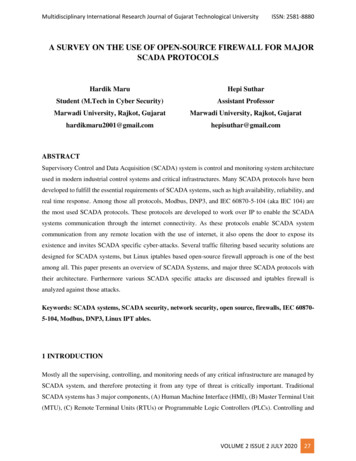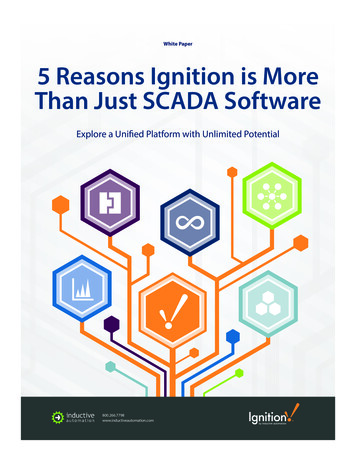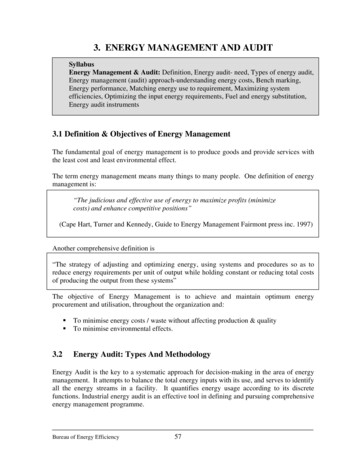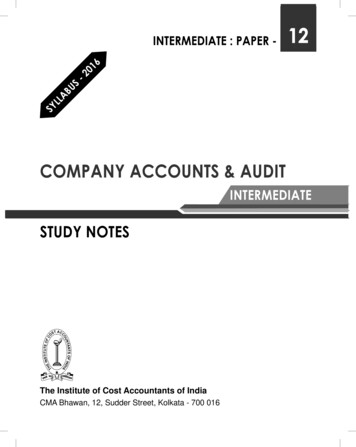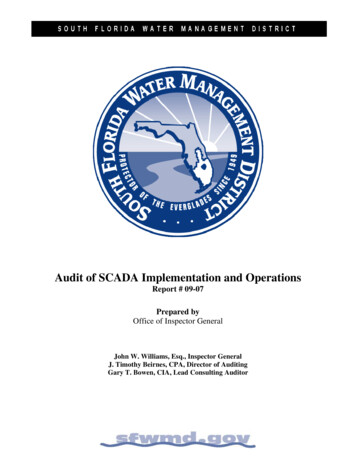
Transcription
Audit of SCADA Implementation and OperationsReport # 09-07Prepared byOffice of Inspector GeneralJohn W. Williams, Esq., Inspector GeneralJ. Timothy Beirnes, CPA, Director of AuditingGary T. Bowen, CIA, Lead Consulting Auditor
TABLE OF CONTENTSBACKGROUND .1OBJECTIVE, SCOPE AND METHODOLOGY .2EXECUTIVE SUMMARY .3SCADA OPERATIONS .4Instrumentation Management and Data Collection .4SCADA & Implementation - Warehouse Management .6SCADA Engineering .6Telemetry Spec & Support .8SCADA Analysis .10AUDIT RESULTSExtensive Use of Contract Workers Increases Cost .10Work Order Pricing Could be More Competitive .12Project Costs are Not Capitalized .14Perpetual Inventory of SCADA Electronic Parts Not Fully Implemented .16Internal Orders for Warehouse Materials arenot Linked to Purchase Requisitions.17Procedures Needed to Prevent Unauthorized Release of Materials .18APPENDICESAppendix A – Analysis of Staff vs. Contractors .20Appendix B – Organization Chart of SCADA Instrumentation & Telemetry 21Appendix C – SCADA System Schematic .22Office of Inspector GeneralTable of ContentsAudit of SCADA ImplementationAnd Operations
BACKGROUNDIn accordance with the Office of Inspector General’s Fiscal Year 2009 Audit Plan,we conducted an audit of the Supervisory Control and Data Acquisition Systems(SCADA) Implementation and Operations.SCADA is the infrastructure that remotely operates the District’s water controlstructures and provides operations and hydro-meteorological data. (See the SCADASystem Schematic at Appendix C). SCADA systems include software and hardwarecomponents that scan remote data, log data and system events, alert abnormal conditions,and send operator commands to remote devices such as water control structures to openor close flood control gates.The Operations Control & Hydro Data ManagementDepartment located in the Operations and Maintenance Resource Area manages theSCADA system.The Operations Control & Hydro Data Management Department has two deputydirectors, one to manage SCADA, Instrumentation & Telemetry, and one to manageOperations Control & Hydro Data Management.The mission of SCADA,Instrumentation & Telemetry is to design, install, maintain, and repair environmental t’swatercontrolandhydrologic/meteorological monitoring network. The mission of Operations Control &Hydro Data Management is to produce, manage, and maintain the operational and hydrometeorological data, which provides water quality data needed to support the District’soperational decision making, and monitoring requirements (such as those required underthe Everglades Forever Act, and the Everglades Settlement Agreement).SCADA, Instrumentation & Telemetry is composed of the following divisionsand sections (see organization chart at Appendix B):¾ SCADA Instrumentation Division Instrumentation Management and Data Collection – (Maintenance) SCADA & Instrumentation – (Includes Warehouse Asset Management)¾ Telemetry Spec & Support Division SCADA Engineering – (Installation) Telemetry Spec & Support – (Programming and Set-up) SCADA Analysis – (Control Room Support)Office of the Inspector GeneralPage 1Audit of SCADA Implementationand Operations
OBJECTIVE, SCOPE AND METHODOLOGYThe main objective of the audit was to examine the internal controls over theSCADA implementation and operation processes.The audit reviewed the internalcontrols in the processes relating to installing, maintaining and accounting for SCADAoperations. Specifically, the audit reviewed procedures and controls related to: 1) costefficiency of outsourcing installation and maintenance contracts; 2) vendor selection andoversight for installations and maintenance; and 3) parts inventory procedures, includingwarehousing and parts issued to vendors.Our methodology included:¾ Interviewing project managers and warehouse support staff to gain anunderstanding of the parts inventory and warehouse process¾ Visiting and observing the warehouse operations¾ Reviewing the available documentation and controls over warehouse andmaterials issuance processes to ensure compliance with appropriate procedures¾ Sampling installation and upgrade projects and reviewingsupportingdocumentation related to materials provided to contractors¾ Reviewing process and status of the warehouse inventory system implementation¾ Interviewing project managers, installation, maintenance and support staff to gainan understanding of the vendor selection and oversight process¾ Reviewing documentation and controls over contractor selection and oversightprocesses to ensure compliance with the District’s procurement policies andprocedures¾ Analyzing the cost of SCADA installation and maintenance and comparing thecost of outsourcing for those services versus the cost of performing thoseactivities by District personnel¾ Reviewing the current status of the SCADA system and the plans for replacementand upgrade of system components¾ Reviewing prior audit and investigation reports and following up onrecommendationsOffice of the Inspector GeneralPage 2Audit of SCADA Implementationand Operations
In addition, SCADA, Instrumentation & Telemetry’s division directors andsection managers were interviewed to obtain an understanding of their division’s purposeand function, staffing levels, and major projects and budget items.Our audit was conducted in accordance with Generally Accepted GovernmentAuditing Standards. These standards require that we plan and perform the audit to obtainsufficient, appropriate evidence to provide a reasonable basis for our findings andconclusions based on our audit objectives.We believe that the evidence obtainedprovides a reasonable basis for our findings and conclusions based on our auditobjectives.EXECUTIVE SUMMARYOverall, our audit revealed that the SCADA implementation and operationprocesses are adequate for installing, maintaining, and accounting for SCADAoperations. However, processes and controls over parts inventory could be improved,problems relating to expensing capital project costs need to researched and corrected, andinstallation and maintenance costs could be reduced based on our findings andrecommendations.We found that the Instrumentation Management & Data Collection and SCADAEngineering Sections make extensive use of contract workers for the maintenance,upgrade, and installation of SCADA sites. We reviewed and concur with SCADAmanagement’s analysis and estimate that an equivalent of 39 contract workers could bereplaced by 25 in-house staff. This would result in potential savings of 9.254 millionfrom Fiscal Year 2009 through Fiscal Year 2014, or potential savings of 1.04 million to 1.813 million each year.We also found that the process for awarding project work orders was not ascompetitive as it could be.Projects are awarded on a rotating basis among eightcontractors who were all selected following submissions of Request for Proposals. Sincethe work orders are not open for bids to all eight firms, but to the contractor next on therotation list, the process appears to lack competition and may result in greater cost.In addition, we found that a perpetual inventory of SCADA parts was in theprocess of being implemented. We were unable to completely review and test theOffice of the Inspector GeneralPage 3Audit of SCADA Implementationand Operations
accuracy of the inventory records because they were incomplete at the time of the audit.However, based on the implementation process being 90% completed, and ourunderstanding of the procedures planned to be implemented, it appears the proceduresand controls will be sufficient. SCADA management is encouraged to complete fullimplementation of the perpetual inventory system.We also tested project cost accounting and found that the costs associated with sixof 10 contractor’s installation work orders were expensed instead of capitalized. Thecapital costs that were incorrectly expensed totaled 161,857.In addition, parts supplied to contractors from District inventories could not beeasily traced and verified to installation at specific sites in accordance with the workorder. Also, there were no procedures in place to ensure parts were released only toauthorized individuals.SCADA OPERATIONSThe functions of each section of the SCADA, Instrumentation & TelemetryDepartment are discussed in the following sections.Instrumentation Management and Data CollectionThe Instrumentation Management and Data Collection section is responsible forthe maintenance of the SCADA sites. The section has 25 full time employees and alsoutilizes the equivalent of 10 additional personnel supplied under maintenance contractswith 9 different contractors. According to the SCADAInstrumentation and Telemetry Maintenance Database(SCADA Site Information Report), the followingrepresents a breakdown of the active and inactiveSCADA sites which are serviced by a combination ofcontractors and District employees.Remote Gate StructureOffice of the Inspector GeneralPage 4Audit of SCADA Implementationand Operations
Active SCADA SitesSite Family (1)Active Sites Under Maintenance Service Campbell (a)ContractsMOSCAD (b)Total Active Sites Serviced Under ContractActive Sites Serviced In-HouseCampbellMOSCADRACU (c)Total Active Sites Serviced In-HouseTotal Active SCADA SitesNumber of Sites536164700245109934471147Inactive SCADA Sites (2)Inactive Sites Under ContractsCampbellMOSCADTotal Inactive Sites Serviced In-House13013111012Total Inactive SCADA Sites25Total Inactive Sites Under ContractsInactive Sites Serviced In-HouseCampbellMOSCADRACUTOTAL SCADA SITES1172(1) Site Families:a) Campbell Scientific data logger (CR-10) is primarily used for measurement and controlfunctions. The data logger can remotely measure hydrologic, meteorological, and waterquality information, with on-site data storage capacity, and it can transmit the data to thecontrol center. The system includes a power supply, weatherproof enclosure, sensors,programming and communications software, and communications peripherals.b) MOSCAD (Motorola Supervisory Control and Data remote terminal unit (RTU) is amicroprocessor controlled electronic device which interfaces mechanical devices such asflood control gates, pumps, etc. to the SCADA system by transmitting telemetry data to andfrom the system. The RTU enables, for instance, the ability to remotely open or close floodgates, or turn on or off pumps. It also has the capability of performing sensor functions andproviding continuous monitoring, although it is not primarily used for those purposes.c) RACU (Remote Acquisition Control Unit) is in the process of being phased out and replacedwith MOSCADS. While it has the capability of remotely collecting data and controllingmechanical devices, it has no data storage capacity and has an obsolete operating system.(2) Inactive Sites:Inactive Sites are sites which have been damaged or vandalized and are no longer functional.They are inactivated and no longer maintained. The electronic parts are removed to preventfurther damage or loss until funds become available to refurbish and reactivate the site.Office of the Inspector GeneralPage 5Audit of SCADA Implementationand Operations
SCADA & Implementation - Warehouse ManagementThree full time equivalent (FTE) employees are responsible for the partsinventory and warehouse operation. The warehouse section maintains an inventory ofparts, which are used in the installation and maintenance of the SCADA equipment. Thewarehouse deals with two broad categories of parts; rotables (defined as: spare partswhich can be restored close to new condition), and consumables (items which are usedup, expendable, or non-refurbishable). Currently, the warehouse keeps two separateinventories, one for the installation group, and one for the maintenance group.Rotables are entered into SAP inventory records when received, and must be“asset tagged” within three days of receipt. Contractors no longer provide any rotable ormost consumable materials except for miscellaneous supplies for installations or repairs,but rather, all such items are to be supplied bythe District warehouse, as reflected in theStatements of Work.The reason being 1)equipment installations and repairs can remainstandardized if all the parts and components arefrom a single source, and 2) consumable itemscan be better controlled and accounted for, andthere is less likelihood of a contractorover - billing for parts.District Parts WarehouseSCADA EngineeringThe SCADA Engineering section consists of six FTE’s, whose primaryresponsibilities are managing the installation projects. Outside contractors perform mostof the installation work, with the equivalent of 29 contract employees.New Sites Under ConstructionSite FamilyCampbellMOSCADTotal SCADA Sites Under ConstructionNumber of Sites281745There are several contractors which the District uses to perform site upgrades andinstallations. There are eight contracts totaling 2,201,907, relating to installation andOffice of the Inspector GeneralPage 6Audit of SCADA Implementationand Operations
upgrades of CR10 sites. Multi-Year Campbell Scientific Installation Services funding isas follows:Fiscal YearFunding AmountOctober 1, 2007 – September 30, 2008 733,969October 1, 2008 – September 30, 2009October 1, 2009 – September 30, 2010Total 733,969 733,969 2,201,907There are five contracts totaling 2,750,000 relating to MOSCAD sites. MultiYear MOSCAD Installation Services funding is as follows:Fiscal YearFunding AmountOctober 1, 2008 – September 30, 2009 900,000October 1, 2009 – September 30, 2010 925,000October 1, 2010 – September 30, 2011 925,000Total 2,750,000Specific work orders are awarded to approved contractors for new installations on arotating basis in accordance with a contract tracking methodology developed by theSCADA Engineering section. This methodology takes into consideration past contractorperformance (including quality and timeliness of project completion), amount of contractremaining, and status of previously awarded work.There are three contracts totaling 8,416,656 relating to Data Logger AreaRecorder Maintenance. Multi-Year Data Logger Maintenance funding is as follows:Fiscal YearFunding AmountOctober 1, 2007 – September 30, 2008 953,462October 1, 2008 – September 30, 2009 3,365,489October 1, 2009 – September 30, 2010 3,365,489October 1, 2010 – September 30, 2011 732,216TotalOffice of the Inspector General 8,416,656Page 7Audit of SCADA Implementationand Operations
The Field Infrastructure Components of the SCADA sites consistof the following systems:¾ Sensors – environmental, structure monitoring¾ Actuators – pump, gate control¾ Remote Terminal Units (RTUs) - RACUs, MOSCADS, CR1000s¾ Data acquisition, test, maintenance, problem-tracking systemsCR 10 Data LoggerThe SCADA components support and maintain the following types of hydrologic,meteorological, and water quality monitoring sites:Type ofApproximateMonitoring SiteNumber of SitesGroundwater Well Sites503Rainfall Sites312Flow Sites575Water Level Sites843Weather Sites58Water QualityMonitoring:Fish, Birds, and Other103Groundwater176Sediment117Surface Water Grab Stations1268Auto Samplers266Total Sites4,221Monitoring Station on Lake OkeechobeeTelemetry Spec & SupportThe Telemetry Spec & Support section employs approximately six FTE’s whoare responsible for programming and setting up the electronic equipment used forSCADA including the CR1000, MOSCAD, and telemetry systems. Specifically, theOffice of the Inspector GeneralPage 8Audit of SCADA Implementationand Operations
section’s Systems Engineering Analysts design and implement interfaces betweensystems, networks, middleware, databases, and programmable remote terminal units.The section is also responsible for configuring the system and installed devices to allowfor remote control and system performance monitoring. They develop, maintain andupgrade the process control computer system, including database management,networking, programming, and configuring programmable logic control systems anddistributed control units.The section is also involved in the development of the telemetry infrastructure, aswell as the management, operation, and maintenance of the SCADA telemetry system.The District has one of the largest water control systems in the country which spansnearly 5,000 squaremiles with over 200major water controlsiteswhichutilizemicrowave telemetryand other OSCADOffice of the Inspector GeneralElectronics PanelPage 9Audit of SCADA Implementationand Operations
SCADA AnalysisApproximately eight FTE’s are responsible for providing support in theEmergency Operations Controls Center, whichmonitors and controls over 200 major water controlsites via microwave and other electronic dataacquisition systems on a 24/7 basis.Additionally, the section is responsible for: Operating the District’s regional water controlsystem’s extensive network of canals, levees,pumps, gates and spillways, Gate Structure on C-44Communicating and coordinating water control equipment status, readiness, andrequired maintenance with Field Operations staff and other governments, and Serving as the 24 hour State Warning Point for the Emergency SatelliteCommunications System.AUDIT RESULTSExtensive Use of Contract Workers Increases CostThe SCADA, Instrumentation & Telemetry Department in Fiscal Year 2008prepared an extensive and comprehensive analysis of the cost effectiveness of using inhouse full time equivalent employees (FTE’s) rather than outsourcing the work tocontractors to perform maintenance and installations of SCADA sites and equipment.The analysis was reviewed and the assumptions were validated as part of the auditprocedures. (See Appendix A for details of the analysis.)The analysis is based on the following assumptions:¾ Estimated 15 FTE’s were needed for installations versus 29 estimated contractorsdue to efficiencies in process control and volume of work.¾ Estimated 10 FTE’s were needed for maintenance and repair versus 10 estimatedcontractors. (A comparable number of FTE’s was needed for maintenance andrepairs because of the geographical dispersion of site locations).Office of the Inspector GeneralPage 10Audit of SCADA Implementationand Operations
¾ Twenty vehicles (pick up trucks, trailers, airboat, etc.) are needed. These costs areamortized over eight years.¾ Twenty five computers are needed @ 1500 each, amortized over three years.¾ Tool kits, uniforms, etc. - 25 @ 200 each, amortized over three years¾ Tools and equipment needed for installations 20,000 per year.¾ Average annual contract increase estimated at 4%.¾ Average salary increase estimated at 3%The summary analysis extends from Fiscal Year 2008 through Fiscal Year 2014,and indicated potential savings of 9.3 million through the period, or potential savings of 1.0 million to 1.8 million per year.FY 08FY 09FY 10 1,919,240 1,604,573 2,850,131 2,964,136 0.00Cost to Perform In-houseCost to Continue ContractsEstimated SavingsACCUMULATED SAVINGSFY 11FY 12FY 13FY 14 1,649,733 1,696,247 1,744,156 1,793,503 3,082,702 3,206,010 3,334,250 3,467,620 3,606,325 1,044,896 1,478,129 1,556,277 1,638,003 1,723,464 1,812,822 1,044,896 2,523,025 4,079,302 5,717,305 7,440,769 9,253,5916 YearsAverage Annual Savings 1,542,325Recommendation1. Consider hiring full time employees to perform SCADA work that isconsidered permanent and ongoing.Management Response:Management concurs with recommendation. SCADA staff developed a staffinganalysis that showed a need for 25 FTEs to replace site installation contractorswith a cost savings of 1 million per year once implemented. The FY09 budgetincluded authorization to hire 10 staff to replace contractors. This was part one ofa multi-year proposed replacement of contractors with FTEs for long-termongoing core work efforts. No new positions were included in the FY10 budget.Staff is reviewing the contractor transition plan and will propose additional FTEsin FY11. Until the transition is complete, the District will have to continue to relyOffice of the Inspector GeneralPage 11Audit of SCADA Implementationand Operations
upon some level of contracting to provide SCADA installation andmaintenance/repair services.Responsible Department:Operations Control and Hydro Data Management DepartmentEstimated Completion:OngoingWork Order Pricing Could be More CompetitiveThe nine contractors currently used for SCADA installation, maintenance, andrepairs, were all selected resulting from Requests for Proposals submitted in May 2007.Only one of the respondents was not awarded a contract because they did not meet thereference check requirement and was therefore deemed non-responsive.Because of the volume of work to be done in this area, all responsive andresponsible responders to the Request for Proposal were approved and individualcontracts were negotiated. Under the contracts signed with each vendor, labor rates werenegotiated at the time of contract execution. These labor rates vary significantly fromfirm to firm. Work orders are rotated among the selected firms as the District negotiatesthe price of the work order based on the statement of work and the contractual labor rates.Since hourly rates are already established when the contract is executed, each workorder’s price entails negotiating the number of hours and material costs. This processdoes not ensure the best price to the District. Allowing all eight qualified firms tocompetitively bid on each work order would help ensure the lowest cost to the District.Recommendation2. Allow all approved contractors the opportunity to bid on each work order,and select the lowest bidder to ensure the best possible price is obtained.Office of the Inspector GeneralPage 12Audit of SCADA Implementationand Operations
Management Response:Management concurs with recommendation. Operations Control and Hydro DataManagement Department will work with the Procurement Department to developa procedure where all contractors are invited to meet with staff at sites whereinstallation or maintenance work will be available and submit bids for each workorder. Management anticipates that implementing this process may reduce thecontracted cost due to additional competition. It could also provide the additionalbenefit of reducing the amount of time required if the selected contractor cannotperform the work, because we will already have bids from other vendors and theopportunity to go to the next lowest bidder.Responsible Department:Operations Control and Hydro Data Management DepartmentEstimated Completion:September, 2010Office of the Inspector GeneralPage 13Audit of SCADA Implementationand Operations
Project Costs are Not CapitalizedThe Asset Master Record for SCADA projects was not always set up correctly inSAP. This is required to be set up for site installation and upgrade project costs to beproperly capitalized. In addition, an incorrect type code is often used on the SAP InternalOrder which causes the project cost to be expensed.We noted that the project costs for six of ten projects sampled were expensedwhen they should have been capitalized, as illustrated in the following 410000010110054447EOC950000265210060215COWCRK, PAIGE,PALM, STOR,S65ERTCWDLJOE, 3A11,G3A11, KEA846G354C, G393BS65A, S65E, 065359LASPALBF2, LABPW2Asset SetupDelivery DateNO - ItemsExpensedNO - ItemsExpensedYES1/1/2009AmountExpensed 30,5609/11/2008 NO - ItemsExpensedNO - ItemsExpensedNO - ItemsExpensedNO - ItemsExpensed10/28/20081/5/2009-0 58,16412/20/2008 11,98010/31/2008 20,80212/31/2008 19,465TotalExpensed 161,857Also contributing to the condition is the observation that the wrong order typecode is often used on the Internal Order (the SAP document used to initiate a project anddetermine how the costs will be charged, i.e., expensed or capitalized). Using the ordertype ZZIO on the Internal Order will cause the cost item to be accounted for as anoperating expense. However, using the order type ZAUC on the Internal Order willcause the project costs to be properly coded as an asset under construction (populating theAsset Master Record), and allowing the costs to be transferred to the asset number set upwhen the project is completed.Office of the Inspector GeneralPage 14Audit of SCADA Implementationand Operations
All of the six projects were expensed because the type code ZZIO was used on theInternal Order, and no Asset Master Record was set up. It is likely that many, if not mostof the new SCADA installations since conversion to the SAP system have been expensedrather than capitalized.Recommendation3. Research SCADA projects completed since the District’s conversion to SAPto determine whether or not they were properly capitalized, and makecorrections where necessary. In addition, written procedures for creatingSAP Internal Orders and Asset Master Records should be communicated toappropriate parties to ensure future project costs are capitalized and notexpensed.Management Response:Management agrees that new SCADA site installations should be captured andcapitalized as part of the District’s fixed asset records. Internal orders have beencreated (order type ZAUC) in order to capture and capitalize new SCADA siteinstallations.District standards for creating SAP internal orders and asset master records arebeing incorporated into O&M’s standard operating procedures and work processflows for new SCADA site installations, which includes a step to request aninternal order for each new site to be installed.However, management does not believe that there is a benefit to be derived fromgoing back and posting adjustments to capitalize equipment costs that have beenexpensed in a prior year because 1) the costs are immaterial to the financialstatements and 2) not having this equipment as part of our fixed asset records willin no way impede our ability to track and control this equipment because it iscurrently in service and collecting data.Office of the Inspector GeneralPage 15Audit of SCADA Implementationand Operations
Responsible Department:Operations Control and Hydro Data Management Department and O&M BusinessServices staffEstimated Completion:September 2010Perpetual Inventory of SCADA Electronic Parts not Fully ImplementedThe SCADA & Implementation Warehouse section maintains an inventory of parts,which are used in the installation and maintenance of SCADA equipment. Deficienciespreviously reported by the Office of Inspector General related to record keeping andcontrol over the parts inventory are being addressed by implementing a perpetualinventory system through the SAP materials management module. A complete andaccurate listing of SCADA parts, including location, part number, serial number,quantity, etc. did not previously exist. Commendably, staff is in the process of updatingthe asset inventory by verifying and correcting errors and omissions. According to staff,this process is approximately 90% complete.When the asset inventory is complete, the District will be able to properly trackand identify assets located at each SCADA field site, as well as the warehoused inventoryparts. The record keeping system will be capable of tracking assets and parts by specificlocation, including field sites, warehouse, district vehicles, contractors vehicles, repairlab, etc.In addition, it was observed that security has been increased by limitingwarehouse access and establishing better physical control over parts reserved and setaside for contractor pick up. We noted during a tour of the facility that access to thefacility is limited by a locked gate. In addition, it appeared that all of the parts stored inthe warehouse exhibited a bar code tag, which will be used in conjunction with the SAPperpetual inventory system to record and track the location of the parts. Warehousepersonnel and personnel in the field will be able to scan and update the part’s location.Office of the Inspector GeneralPage 16Audit of SCADA Implementationand Operations
Recommendation4. Complete the preparation and verification of an accurate and detailed list ofall District owned SCADA parts installed at sites, located in the warehouse,or issued to in-house or contract installers.Management Response:Management concurs with the need to have this information reflected in the assetrecords of each site, and are implementing changes to the current business processto capture this information going forward. The serialized asset data is reflected inthe equipment master record for each piece of equipment installed in a functionallocation (field site) in SAP.However, we do not have an inventory of equipment by serial numbe
Hydro Data Management is to produce, manage, and maintain the operational and hydro-meteorological data, which provides water quality data needed to support the District's operational decision making, and monitoring requirements (such as those required under the Everglades Forever Act, and the Everglades Settlement Agreement).
